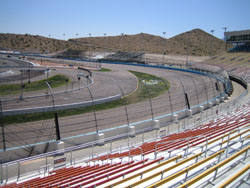- PHOENIX,AZ-The Phoenix International Speedway (PIS) recently expanded its facilities and was in need of a PA system to complement the new bleachers and skyboxes. But instead of adding more horns and old squawk boxes, the owners of the speedway decided to update its sound system. In the past, emails and phone calls would pour in after each race, complaining of the sound quality and the poor intelligibility of the announcer.
- Hoping to raise the entertainment value and quell criticism, the owners of the PIS went to SLS Audio.
The SLS LS6593 are line array columns mounted directly on the track fences, angled up at the bleachers at the Phoenix International Speedway. There are 11 arrays spaced about 140 feet apart.
They decided to go with SLS's newly developed LS6593, based on their throw and wide bandwidth. The LS6593 models are line array columns designed to stack and the speedway owners wanted to mount them directly on the track fences, angled up at the bleachers, so they enlisted the expertise of local contractor Sound Image to put the system together. This ended up being more difficult than imagined because the LS6593 was so new, they hadn't even been manufactured yet.
Marty Waverly, GM and engineer for Sound Image described the challenge of putting together the design on spec sheets alone. "We had to fabricate our own mounting brackets. That was a major challenge, fabricating and anodizing the brackets to mount to the poles. We had only a drawing from SLS until about a month until the install, so we actually had to sit down and fabricate those ourselves and figure out how they mount. There's three speakers mounted on each pole and then we had to mount them out on the fence and make them structural."
Waverly's team spent a lot of time trying to integrate the new and old wiring around the track, as well as tweaking the track's amplifiers. They did a lot of testing to see what would work with the track's limited conduits because they couldn't cut up through the bleachers or the track. "We worked to get cabling out there because the old wiring was horrible," said Waverly. The new section had a new amp room that Sound Image had to break into two systems. "We had to try to find the fiber run they had all around the track, feeding those amplifiers. With the Crown IT8000s, we needed a clean signal and we had a little issue with that. They're also running audio over RF off the fiber. It was a bit of a challenge cleaning up the system while still giving them expansion as far as control with the network HiQnet off the Crown amps to power up and down all those amps from the sound booth," Waverly explained.
When the speakers finally arrived it was two weeks until the next race, so time was of the essence. Compared to the old speakers that were mounted on each pole of the fence, the new columns were mounted on every forth pole. They also used the same speakers on the backside of the grandstands with 70 volt transformers in them shooting off the back of the bleachers into the midway section to feed all the causeways. There's no control system, just infrastructure and HP Pro Curve switches. The speakers are set like a line array but tilted in the opposite way. The track is bent backwards, so the line array bends up, shooting up into the bandstands. There are 11 arrays spaced about 140 feet apart. Waverly's team used signal processing in the 8000s and did a lot of sound checks with SLS. "We did a basic set up and they came in and did a few curves." No one had ever used ribbon tweeter technology at a racetrack before, so the outcome was uncertain. Waverly spoke of the outcome with disbelief. "It worked out better than we had anticipated. We actually had 94dB 35 to 40 rows up, louder than it was right in front of the speaker. It was an audio anomaly. They were the best speakers for the project. There really isn't anything that has that much dispersion, to throw that far, being weatherized."










